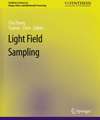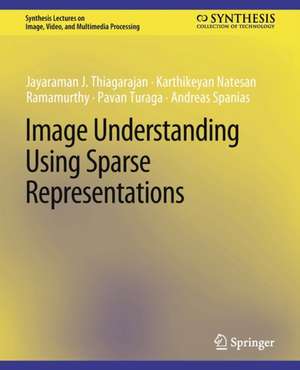Image Understanding using Sparse Representations: Synthesis Lectures on Image, Video, and Multimedia Processing
Autor Jayaraman J. Thiagarajan, Karthikeyan Natesan Ramamurthy, Pavan Turaga, Andreas Spaniasen Limba Engleză Paperback – 24 apr 2014
Din seria Synthesis Lectures on Image, Video, and Multimedia Processing
-
 Preț: 428.68 lei
Preț: 428.68 lei -
 Preț: 191.30 lei
Preț: 191.30 lei -
 Preț: 206.84 lei
Preț: 206.84 lei -
 Preț: 450.88 lei
Preț: 450.88 lei -
 Preț: 234.87 lei
Preț: 234.87 lei -
 Preț: 191.30 lei
Preț: 191.30 lei -
 Preț: 264.20 lei
Preț: 264.20 lei -
 Preț: 193.01 lei
Preț: 193.01 lei -
 Preț: 260.77 lei
Preț: 260.77 lei -
 Preț: 234.87 lei
Preț: 234.87 lei -
 Preț: 234.87 lei
Preț: 234.87 lei -
 Preț: 234.87 lei
Preț: 234.87 lei -
 Preț: 234.87 lei
Preț: 234.87 lei -
 Preț: 311.69 lei
Preț: 311.69 lei -
 Preț: 351.41 lei
Preț: 351.41 lei -
 Preț: 234.87 lei
Preț: 234.87 lei -
 Preț: 234.87 lei
Preț: 234.87 lei -
 Preț: 262.47 lei
Preț: 262.47 lei -
 Preț: 234.87 lei
Preț: 234.87 lei -
 Preț: 206.45 lei
Preț: 206.45 lei
Preț: 261.53 lei
Nou
Puncte Express: 392
Preț estimativ în valută:
50.04€ • 52.39$ • 41.41£
50.04€ • 52.39$ • 41.41£
Carte tipărită la comandă
Livrare economică 07-21 aprilie
Preluare comenzi: 021 569.72.76
Specificații
ISBN-13: 9783031011221
ISBN-10: 3031011228
Ilustrații: XI, 106 p.
Dimensiuni: 191 x 235 mm
Greutate: 0.22 kg
Editura: Springer International Publishing
Colecția Springer
Seria Synthesis Lectures on Image, Video, and Multimedia Processing
Locul publicării:Cham, Switzerland
ISBN-10: 3031011228
Ilustrații: XI, 106 p.
Dimensiuni: 191 x 235 mm
Greutate: 0.22 kg
Editura: Springer International Publishing
Colecția Springer
Seria Synthesis Lectures on Image, Video, and Multimedia Processing
Locul publicării:Cham, Switzerland
Cuprins
Introduction.- Sparse Representations.- Dictionary Learning: Theory and Algorithms.- Compressed Sensing.- Sparse Models in Recognition.- Bibliography.- Authors' Biographies .
Notă biografică
Jayaraman J. Thiagarajan received his M.S. and Ph.D. degrees in Electrical Engineering from Arizona State University. He is currently a postdoctoral researcher in the Center for Applied Scientific Computing at Lawrence Livermore National Laboratory. His research interests are in the areas of machine learning, computer vision, and data analysis and visualization. He has served as a reviewer for several IEEE, Elsevier, and Springer journals and conferences.
Karthikeyan Natesan Ramamurthy is a research staff member in the Business Solutions and Mathematical Sciences department at the IBM Thomas J. Watson Research Center in Yorktown Heights, NY. He received his M.S. and Ph.D. degrees in Electrical Engineering from Arizona State University. His research interests are in the areas of low-dimensional signal models, machine learning, data analytics, and computer vision. He has been a reviewer for a number of IEEE and Elsevier journals and conferences.
Pavan Turaga is an AssistantProfessor with the School of Arts, Media, and Engineering and the School of Electrical, Computer, and Energy Engineering at Arizona State University, since 2011. Prior to that, he was a Research Associate at the Center for Automation Research, University of Maryland, College Park, MD, from 2009-11. He received M.S. and Ph.D. degrees in Electrical Engineering from the University of Maryland, College Park, MD, in 2008 and 2009 respectively, and the B.Tech. degree in Electronics and Communication Engineering from the Indian Institute of Technology, Guwahati, India, in 2004. His research interests are in computer vision, applied statistics, and machine learning with applications to human activity analysis, video summarization, and dynamic scene analysis. He was awarded the Distinguished Dissertation Fellowship in 2009. He was selected to participate in the Emerging Leaders in Multimedia Workshop by IBM, New York, in 2008.
Andreas Spanias is Professor in the School of Electrical,Computer, and Energy Engineering at Arizona State University (ASU). He is also the founder and director of the SenSIP industry consortium. His research interests are in the areas of adaptive signal processing, speech processing, and audio sensing. He and his student team developed the computer simulation software Java-DSP. He is author of two text books: Audio Processing and Coding by Wiley and DSP: An Interactive Approach. He served as Associate Editor of the IEEE Transactions on Signal Processing and as General Co-chair of IEEE ICASSP-99. He also served as the IEEE Signal Processing Vice-President for Conferences. Andreas Spanias is co-recipient of the 2002 IEEE Donald G. Fink paper prize award and was elected Fellow of the IEEE in 2003. He served as Distinguished lecturer for the IEEE Signal processing society in 2004.
